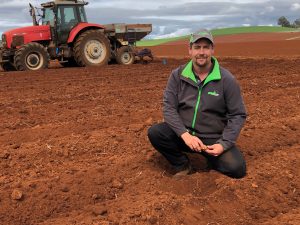Disease control unlocks yield potential
Tuber development and uniformity can be enhanced through greater attention to foliar disease management, from flowering to row closure and beyond. It’s particularly important to consider the application of a foliar fungicide prior to row closure, as you might for any additional nutrition, helping extend the life of the canopy while assisting tuber bulking.
More and more growers have found the application of a preventive foliar fungicide just prior to row closure will lock in protection from target spot (also known as early blight).
Yields can be severely impacted where target spot is allowed to infect crops and take hold. To assist in the battle against target spot, Syngenta has produced MIRAVIS® – a Suspension Concentrate formulation that mixes readily with water and is applied as a spray.
For growers like Lachlan Hauser in the Lockyer Valley, who supplies the processing market, tuber size uniformity and consistency are vitally important.
“We first started using MIRAVIS in 2018,” Mr Hauser said.
“Toward the backend of that season when we did have some target spot pressure, we really noticed the benefits where we did one strip half with MIRAVIS and one without.”
Crop canopy
Target spot is caused by the pathogen Alternaria solani, which can bring about rapid defoliation of potato crops. Without a canopy, there can be no photosynthesis and no production of plant sugars, as well as no tuber bulking.
The ideal timing for MIRAVIS is just prior to row closure, so that it can penetrate the lower canopy where it will stop early infection of target spot.
Rainfast within one hour, the product locks in protection against these fungal spores for up to 21 days. This is especially important during periods of leaf wetness, be it from rain or irrigation.
Extending the length of a crop canopy by even 14 days can make a huge difference to potato yields, particularly late in the season when target spot pressure begins to build and can take over the crop.
Yield improvements
A potato grower on Tasmania’s north-west coast, Tim Walker harvested greater than 70 tonnes a hectare in April 2019.
“Using MIRAVIS to control target spot gave me a significant yield advantage,” he said. “Every day we can keep those leaves green, the yield is growing for us.”
In-season target spot control began at flowering when conditions were more conducive for disease with an application of AMISTAR® TOP at 500 mL/ha. This was followed by the high label rate of the product at 375 mL/ha.
His decision to use and recommend it– as a farmer and lead agronomist of Walker Ag – was supported by the fungicide’s ease of use.
“About half of my clients used it that year and we didn’t see any issues with compatibility,” he said.
“The fact that it’s rainfast within one hour and offers up to 21 days of protection means we’re able to use it late.”

Mr Walker said the efficacy of the fungicide had been no better demonstrated than on his own farm where he missed treating a 40-metre strip.
“I ran out and didn’t bother going back. That strip, which wasn’t treated, died off nearly three weeks sooner,” he said.
“Even if it was only a couple of tonnes difference a hectare, it would be worth using but it’s much better than that. There’s a significant advantage with MIRAVIS. Sometimes it’s these unintended trials that are the most telling.
“My only regret is that I didn’t have a bigger paddock planted.”
This fungicide is compatible with a range of foliar fertilisers enabling growers to make one tank-mix for nutrition and disease in some cases.
It has been proven to reduce disease infection and keep foliage greener for longer when used early at row closure, or when conditions are conducive for disease prior to symptom expression. Ultimately, improved greenness will unleash the crops maximise size and yield potential.
Find out more
Please visit the Syngenta website. Readers can also follow Syngenta on Twitter.
This article features in the autumn 2021 edition of Potatoes Australia. Click here to read the full publication.

